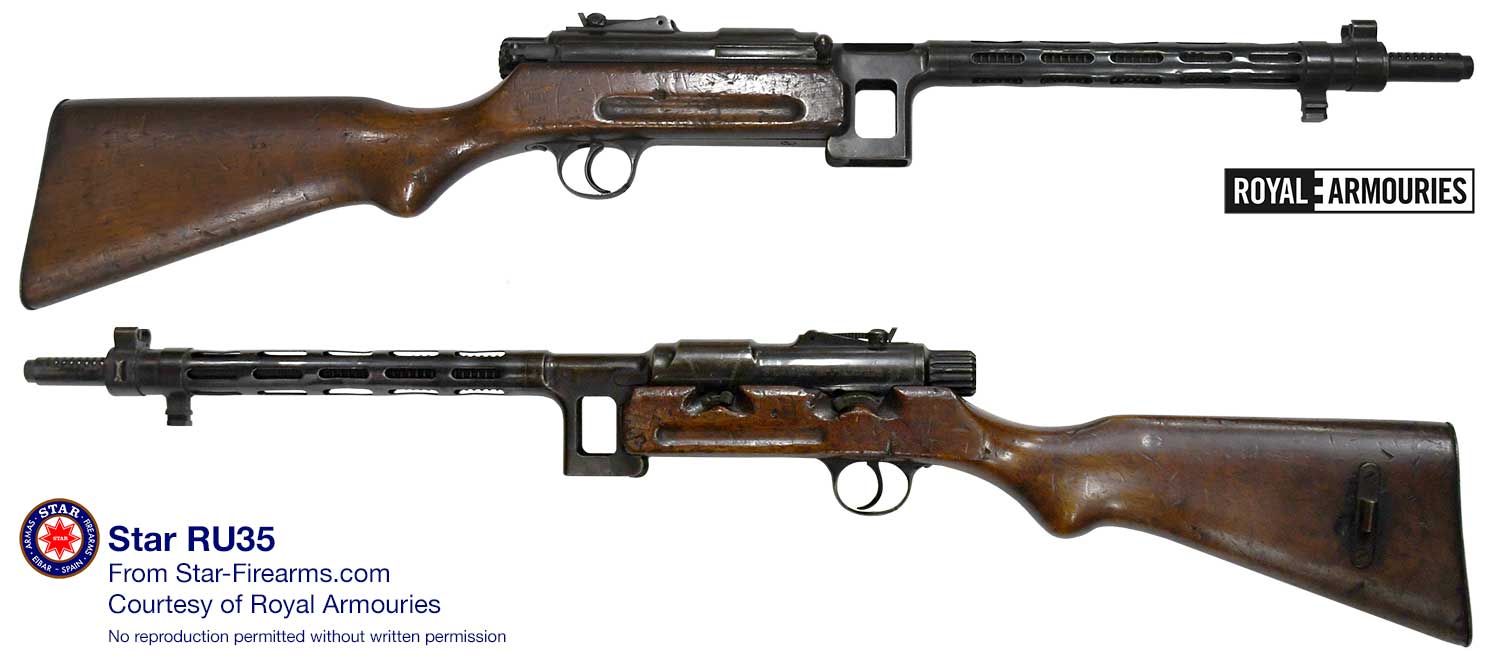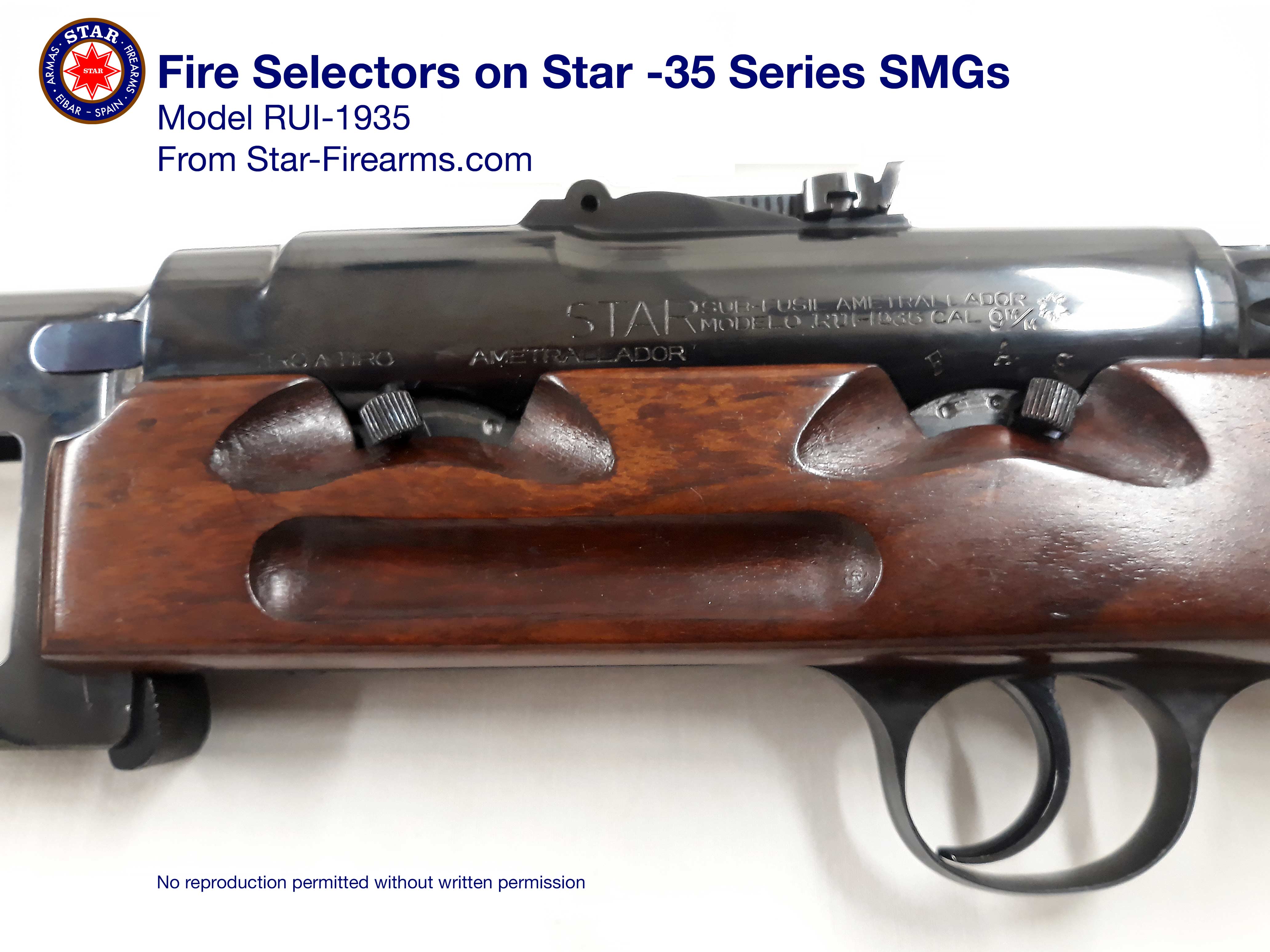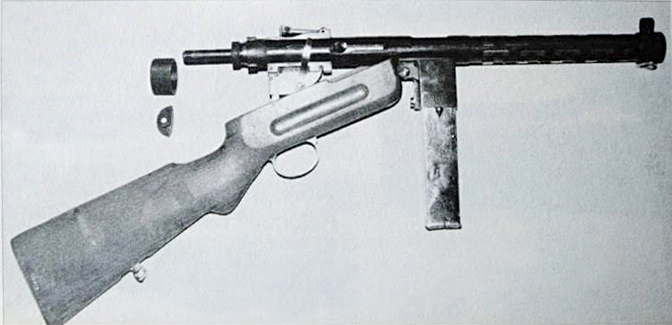Star Firearms — The Si35, RU35 & TN35 sub-machine guns
Despite being known best in the commercial market for handguns, Star's primary business has been in many ways their military submachine guns. The fall of the SMG in the 1980s to the 5.56 mm carbine may even have been a contributing cause of their eventual demise.
From just before the Civil War, until the 1990s, one Star SMG model has replaced another in Spanish army service, as well numerous export countries. For more, read up on stocked- and machine-pistols or find your stocked SMG in the progression of Spanish service weapons:
-35 Series → Z-45 → Z-62 Series → Z-75 & Z-84
The -35 Series SMGs
The 35 series are first generation, full-stocked, tubular receiver, open bolt SMGs, firing 9mm Largo. See the end of the page for details on the variations of each gun.
With the start of the war, the RU 35 and SI 35 were manufactured—in 9 mm Largo of course—for the Republicans, until the capture of Eibar by the Nationalists when production switched to supplying that side. There are no solid numbers, but at most a few thousand were produced in total. Serial numbers are not in the format of the pistol line, and appear to be a simple sequential number. Those I have observed are all very small numbers, some in the hundreds.
Additional variations were made in an attempt to gain commercial or export military sales during the early middle parts of the Second World War. Firing examples were provided for test to at least the US, and British.
Unlike for Star pistols, where the military arms were generally parkerized, all observed specimens of the -35 series SMGs were finely finished, with blued metal and high quality wood. Many have been treated like military arms, so are worn and this may not be clear at a glance.
Overall Layout
The -35 series SMGs are of conventional layout and construction for first generation SMGs. While the bolt and channel is circular in section, the receiver is not a simple tube, or even a steel pressing to that shape, but a complex machining, which includes a locking recess in the tube, so is also heavy enough to support firing stresses.
The -35 series SMGs have a full wooden stock, with a straight comb and a medium sized pistol grip. While the comb is unlike anything issued, probably to help keep the head in place under repeated recoil, the grip is very similar to the contemporary "Spanish" Mauser rifles. A sling swivel is attached to the left side of the buttstock.
The trigger is conventionally placed and configured for rifles of the era, with a deeply hooked trigger, surrounded by a fairly small trigger guard mounted to a plate inletted into the bottom of the stock. The trigger guard plate has holes through which screws are placed. Without further disassembly it is unclear if these only secure the trigger guard plate, the entire fire control system, or are action screws which hold the receiver to the bottom metal also..
There is no evidence a folding stock, or that any breakdown (quick-disassemble) or cut-down versions were made of these guns for use by vehicle crews or parachute troops.
The charging handle is non-reciprocal, and is integrally machined with a sliding plate on the right of the receiver, which reduces the amount the inner workings are exposed to the elements, but is another tightly-fit piece that must be kept clean. It can also interfere with re-assembly and must be positioned properly to insert the bolt assembly.
Magazine
Magazines are straight boxes, with single position feed. Capacities of 10, 30, and 40 rounds are reported. It appears the 30 round was the one most often used, though 10 round models may also have been issued as standard, and are shown inserted in the marketing images where it has a bayonet fitted. This may have been a ploy to make the gun more palatable as a bolt-action rifle replacement, as are the sights, slings, stocks, and bayonet lug itself.
Witness slots, not holes, provide an easy view of the current state of the magazine.

The magazine fits into a chute at the bottom of the receiver, with large holes in the side. These appear to be lightening holes, but are likely provided so the witness slots can be viewed while the magazine is inserted and the capacity viewed even when low.
The magazine release is a lever at the lower rear of the magazine well. Press forward to release the magazine which will drop free, although the lever is best activated by grasping the magazine at the same time and positively removing it by hand.
While this seemed to me a perfectly reasonable arrangement, apparently it was subject to bumping and accidental magazine release, so there were unclear and unspecified changes to the last "Atlantic" model submitted for the US trials. I have observed two styles myself, and it may simply be reducing how much the magazine release sticks out from the receiver.
The bolt will lock back on the last round fired. Though a common and very useful feature today, this was nearly unheard of in the 1930s, and was exceptionally unusual for an SMG, only appearing in guns such as the German H&K MP-5 in the very last versions they made.
Variations, or Changes
I was able to inspect two RU 35 guns (but no other models) at the Royal Armories in Leeds, and found some significant changes over time, which appear to be for reduction of costs of production over time. However, many other changes were not made, and the guns continue to be very complex and expensive to make.
This lack of meeting demand, and the inherent complexity of the gun's design, presumably led to fairly few being made, and their lack of success on the export market in the run-up to the Second World War when guns were otherwise in high demand.
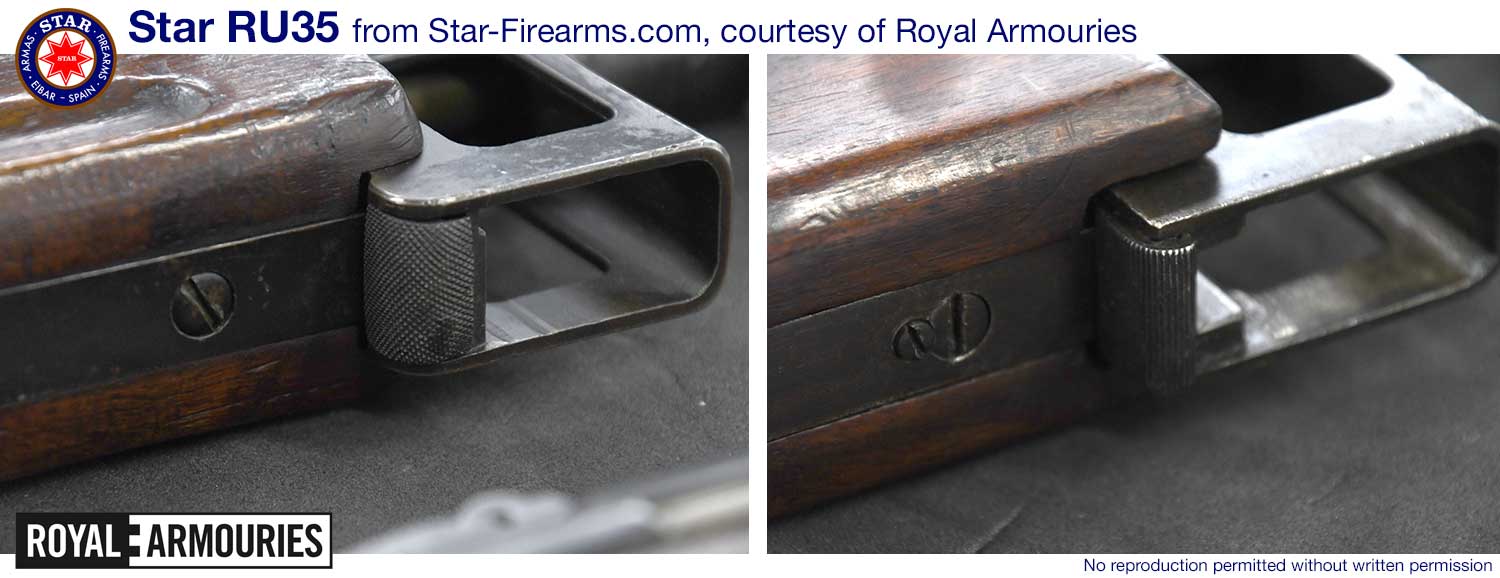
Numerous small changes were made, such as to the knurling on the magazine release
The barrel on all guns has a long section of tapered radial fins for cooling. However, only the older model has a long heat shield to protect the firer from the barrel heat.
The front sight on the older model has protective ears, but these have been removed from the later model.

The older gun is fitted with a complex multi-slot muzzle brake, not unlike a Cutts Compensator. While probably effective, on such a large gun, with a low rate of fire, it is probably not necessary.
The newer gun has a plain muzzle with no flash hider or compensator.
A bayonet lug is also provided on the older model, which accepts the standard Spanish issue M-93 Mauser rifle bayonet.
Disassembly
Basic disassembly is fairly easy, with a simple spin-off rear cap. The cap is deeply grooved, and has a mechanic lock lever that must be depressed. Both these are needless features, adding a lot of machining time, even for the period. Simple knurling and a detent would certainly suffice.
The recoil spring and bolt assembly may then be removed, and the receiver and barrel cleaned.
To access the fire control parts required a screwdriver, and is clearly not a job intended for troops in the field.
Bolt, and Delay Mechanism
This is where the complexity really starts. The -35 series SMGs are not straight blowback, but have a delay mechanism.
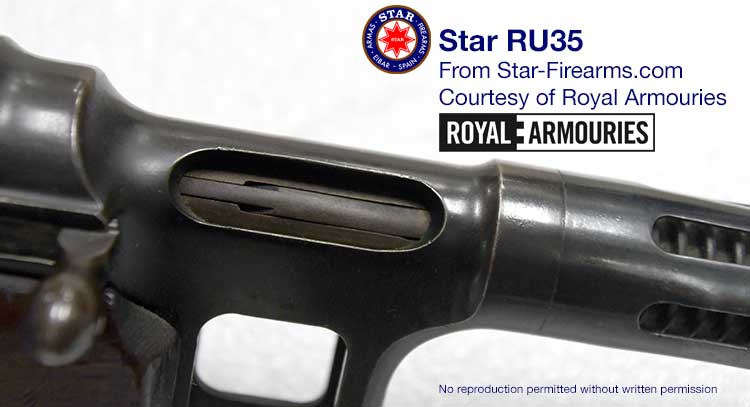
The bolt is a stepped assembly, reminiscent of the design of many a self-loading .22 rifle. A long, narrow bolt about the diameter of the cartridge case protrudes from the front, with an ejector and extractor pinned to, and protruding from the sides.
The much thicker rear contains multiple components, and pretty much falls apart when inverted once removed from the gun. Assembly is fairly simple and the parts are not symmetrical so it cannot be assembled incorrectly.
The rear of the bolt is a linear hammer, which is driven by the recoil spring. Between the two are a locking piece and a delay arm.
When the trigger is pulled, a sear latch retracts into the receiver, allowing the bolt to fly forward, and strip a cartridge from the magazine. Once the bolt head is in battery, the linear hammer continues forward, striking the firing pin and firing the cartridge, but also driving the delay arms into the "locked" position.
The force of firing pushes back on the forward bolt body. It cannot immediately move, as a block is engaged into a cutout in the upper receiver. This block has an angled rear surface, which corresponds to an angled rear surface on the receiver. Especially as the spring force is pressing the block into place, this provides a mechanical disadvantage.
The chamber pressure slowly releases this mechanism, and when the block has dropped sufficiently, the entire bolt assembly is free to move to the rear, compressing the recoil spring, and is ready for the next shot cycle.

The angle of the locking block and cutout will change the delay, and presumably is the method used to control the rate of fire. The angle on the RU 35 inspected at the Royal Armories was very steep, so 300 shots per minute seems plausible.
However, delay mechanisms in SMGs are rare and it is not clear why the Star engineers found it necessary, with such a large gun. Bolt mass, and travel, should have been enough to compensate for the force of firing pistol ammunition.
Fire Control and Lockwork
Perhaps the most unusual part of the -35 series SMGs, and the most poorly communicated and inaccurate, is the fire control system. This is at least partly the fault of Star and the designers. The gun is very complex, and there are several variants.
To understand the fire selection, however, I think we can break it down into two types:
Dual Rate of Fire
All -35 series guns have two selector levers, but the reason for that seems to be the original SI-35 version, and a flexible, but very hard to understand system that enabled semi-automatic and full auto at two rates of fire.
The rear most lever is labeled (back to front) S, A and F. This rotates between the three positions to select between three positions. The rear most is Safe (Seguro), but the others are not so simple. When at any setting other than safe, a red mark is exposed, a very modern feature for the 1930s, and one that Star used again, most notably on the Z-84.
The forward lever is the same size and shape, and moves across the same arc, but has only two positions, for selecting the lower or higher speed rate. I do not have good enough photos of a relevant gun to find the labels, but their transliterations are Retarded (delayed action, or slow) and Rapid
The four available firing modes are, per the Star manual:
| Safe | Semi-Auto | Full-auto Low-Rate (300 spm) |
Full-auto High-Rate (700 spm) |
|---|---|---|---|
 |
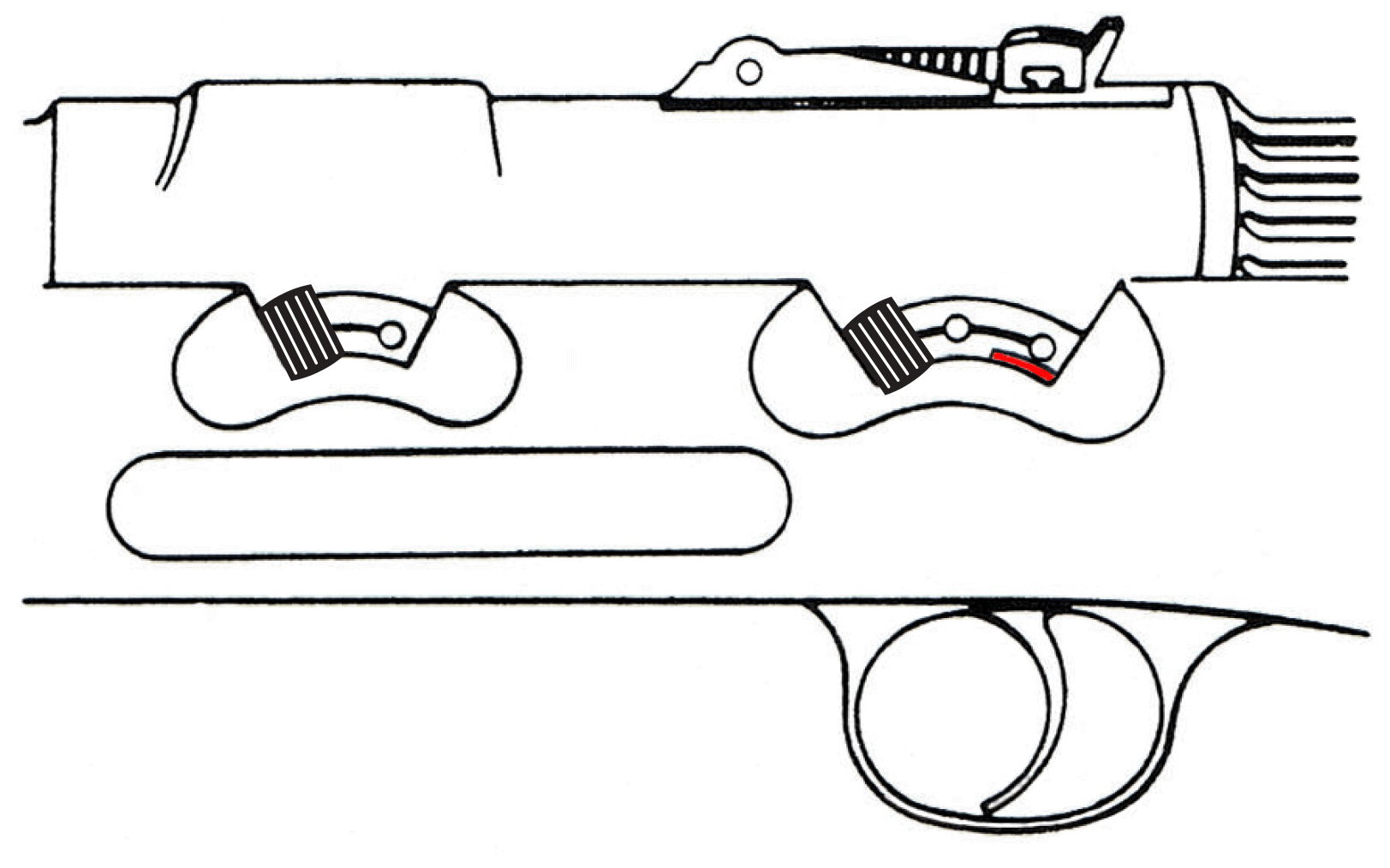 |
 |
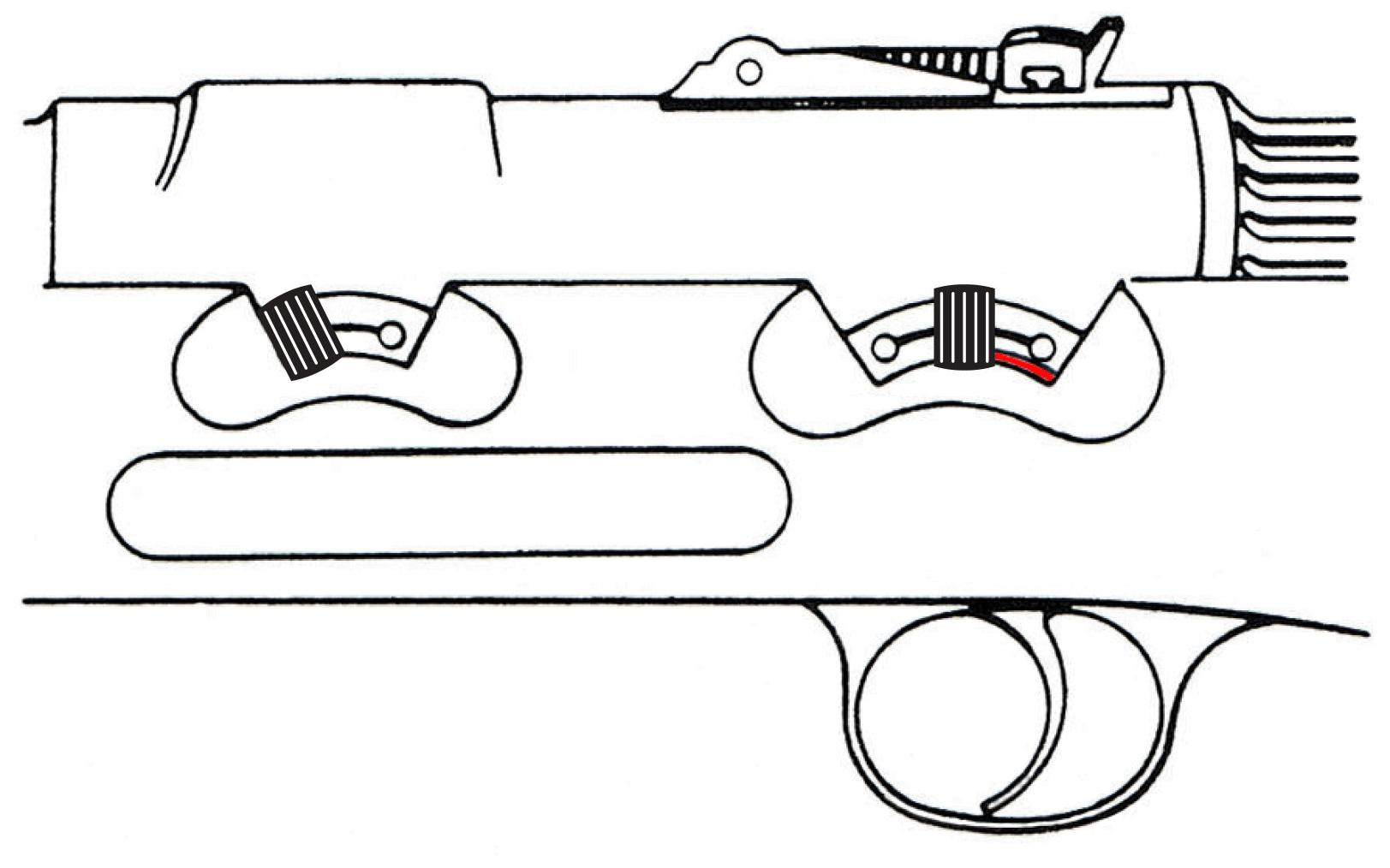 |
Single Rate of Fire
After the very first SMG version, the SI-35, the operation was greatly simplified, though the two fire selectors persisted. Both the RU-35s inspected at the Royal Armories were of this style.
Labels vary slightly in format, but generally the rear lever has only two positions, labeled, (back to front): Seguro (Safe), Fuego (Fire)
The forward lever continues to have two positions, but they are marked, Tiro a Tiro (Shot to Shot, or semi-auto) and Ametrallador (Machine Gun, or full-auto).
When the forward lever is moved on a delay gun such as the RU-35, the gun makes a strangely bouncy mechanical noise unlike a normal gun lockwork click. This apparently is the spring-actuated delay mechanism engaging and disengaging.
The Rate Reducer
A patent was issued to Star, #133,526, in 1934 which covered the operation of a rate reducer mechanism. The delay mechanism is a cylinder under the bolt somewhat to the rear of the magazine. It is pinned into the bottom of the receiver with a large cross-pin. Note that the photographed example is a reproduction, and not entirely representative in materials and finish to the original.
When engaged, the forward fire engages an arm in the left side of the receiver, which bears bears on a deep notch in the left side of the delay body, rotating the entire cylindrical assembly, so that an arm in the middle sticks up into the receiver.
The large outer sleeve of the forward bolt bears on this protrusion. On firing, the delay mechanism is engaged by providing additional pressure on the bolt movement, through a clockwork-like wound spring.
This is not a lock, but just another force to overcome, and operates like adding a larger recoil spring would to any gun; resisting the motion of the bolt slows the action.
Another notch in the rear of the reducer cylinder engages with a lever which prevents the sear from dropping the hammer until the bolt is fully in battery. While an unusual implementation, the use of a "safety sear" to detect that the bolt is in battery became very common on rifle-caliber and larger full-auto firearms later.
The natural rate of fire for the -35 series SMGs, when the delay mechanism is not installed or not engaged, is about 700 shots per second.
With the delay mechanism engaged, this rate of fire slows to approximately 300 shots per second. A seemingly-similar rate reducer has been seen on a rare version of a Model MD selective-fire pistol.
Sights
The sights are very typical for SMGs of this era, and are very similar to the contemporary Spanish M-93 Mauser bolt action rifles – which they would be used alongside in military service. They have an unprotected tangent rear sight able to be adjusted to a very optimistic 1000 m range.
While SMGs are perfectly usable to 200-300 m, able to hit small groups of people with a burst, and single targets with careful aimed shots, 1000 m is nearly impossible due to time of flight, wind drift, and crossing the sound barrier. The bullet will also have lost so much speed that it would be very ineffective on target as well.
The front sight varies on the two versions I inspected, as described above.
The front sight has been observed in two distinct versions, an older/nicer one with protective ears and a simpler tapered post base. Both have a blade, adjustable for windage. The older one has the sight in an angled dovetail, allowing for more fine adjustment, which is not something I have ever seen before, on any other gun.
Models and Variations
Five total types of firearms were produced, including trials guns, all of which sharing the same basic mechanical design, overall look, and most parts.
These are evolutionary steps, presented in the order they were made below, and were not variations offered at the same time in order to give customers options.
The variations below are as the historical record shows, and do not necessarily reflect the guns I have observed, which have apparently evolutionary changes applied to guns with the same model stamped in the side.
IS-34
The first model was a lightly produced pistol caliber carbine, presumably intended for the commercial or police market, with no provision or even consideration for full-auto fire. this may explain the complex delay mechanism, in an attempt to make a very soft shooting gun.
The model name is derived from the year manufacture commenced, and the names of the two designers Valentin Suinaga and Isaac Irusta, the production manager and managing director of Star at the time, respectively. All other models are simply variants on the letters of their names as well and have no other meaning.
SI-35
The first SMG version simply added the complex fire selection mechanisms, but retained the mechanical design, to turn their IS-34 carbine into a submachine gun, for use in the war.
RU-35
In the first attempt to simplify the operation of the gun, but with essentially no reduction in manufacturing cost or complexity, the dual-rate system was removed.
The delay system was retained, but was always engaged when the gun was set to full-auto. The gun fired semi-auto, or full-auto at 300 rpm only
I have also encountered a gun marked RUI-1935, which appears to have the features of the RU-35 with no obvious changes. It is not clear if this is a sub-variant or simply an unusual marking for some reason.
TN-35
Another even simpler version was made in 1938 or -39, too late to be used in the Spanish Civil War. This simply removed the rate reducer, allowing full-auto fire to be at the natural rate, about 700 shots per minute.
It is likely this took so long not because it was technically challenging, but because there was no call for it. Very low rates of fire were common in some early sub machine guns. However, as the technology matured the most common guns coalesced around 550-800 spm. This may have simply been a change to appeal to the international markets and attempt to get foreign military sales.
"Atlantic" Model and Attempted Foreign Military Sales
Starting in 1940, Star tried through their New York based sales office, Atlantic Importing Company, to sell the -35 series SMG to the US military. "A few" SI-35s were tested at Aberdeen Proving Ground in 1940, but rejected over cost to manufacture, and of course the wrong cartridge, when the US was firmly committed to the .45 ACP.
In 1941 a lightly modified TN-35 was offered to Germany and four were sent to the US for testing.
This was generally called the "Atlantic" SMG due to the import agency name, and the sales agent, Cunill de Figuerola, was said to be the designer of the gun as well.
This variant had unspecified simplification to the fire control, a magazine release modified to prevent accidental drops, as well as a wooden grip attached to the front of the magazine well, changes to the bayonet lug, and slings, and was expressly marked as firing the .38 Super cartridge.
Tests were carried out 28-29 August 1942 at Aberdeen, with much the same result. It was old, expensive to make, and the wrong caliber so was rejected for any purposes by US Ordnance.
Following this the British indicated they might be interested and two guns were sent to them, though testing was similar to that in the US and they were not accepted in any sense.
The markings on the guns I observed in the Royal Armories indicate they are likely in 9 mm Parabellum, with both marked "9 m/m." While the two guns had differences, and the information the Armories have on them seems to indicate that one was obtained by the UK Ministry of Defense in 1934, it may be that the two I observed were indeed the test articles from 1942.
Following these sales failures, production of the -35 series was halted in 1942, and never resumed.
The "Cartagena" RU35
The Naval Museum in Cartagena, Spain has an unusual Star RU-35 on display. It is clearly a -35 series SMG, and has a single fire selector so we believe the RU model version, but it has many other odd changes:
- Change to the stock profile, revealing less metal than usual
- Filled in magazine well, which is a separate part as described below in the stripping instructions
- Different charging handle, hooked instead of a stick with ball on the end
- No hump on the top of the receiver. It may be a straight tube, and a straight blowback gun, which would be a very big change
- Front sling loop below the barrel, replacing the bayonet lug
- Different rear receiver cap and method of disassembly
- Very different profile at the rear of the receiver, with a large flat and a screw. This also seems to prohibit disassembly of the gun without tools, which is a strange choice to make for a developed product
- Only a single safety marked S and F, duplicated on both sides. Some reports indicate that this is a semi-auto gun, but I have no reason to believe that it is not a full-auto-only SMG instead.
To strip this gun, only one screw must be removed, on the rear of the receiver. A plate is removed allowing the whole mechanism to pivot about a pin at the rear of the magazine well, not unlike modern automatic rifles. The receiver cap can be pressed in and twisted 90° for removal as it is bayonet lugged, instead of threaded on.
The story gets even more confusing when I was sent information from Barceló Rubí's comprehensive "3 Siglos de Armamento Portátil en España" (3 Centuries of Portable Weapons in Spain). There are only a few examples of this gun across spain, all with serial numbers below 11, most or all without proofs, and most or all without marks indicating they are Star products, despite the apparent similarity to the -35 series.
Rubí speculates it is an early prototype, but for what is not clear. I would speculate another military contract, as the features seem useful to that, or specific to requests for someone, but the gun is in 9 mm Largo, so that means Spanish service almost certainly. At the time, it's unclear who might have wanted a gun like that.
Service & Maintenance
Firearms marked 9 mm / 38 are designed to fire .38 ACP and 9 mm Largo ammunition, but NEVER .38 Super. Read more detail on ammunition for older pistols.
Manuals & Disassembly Instructions
I do not have manuals for every pistol shown on this site. However, in many cases there is a related manual. Partly to make the series relationships clearer, and partly to assist with speed and accuracy of updating, all manuals can be found in one place, the manuals page. All manuals available are provided as downloadable PDFs, or you may purchase a printed copy of the entire set of handgun manuals.
I have no manuals for this series of SMGs.

